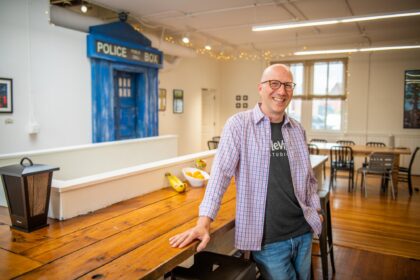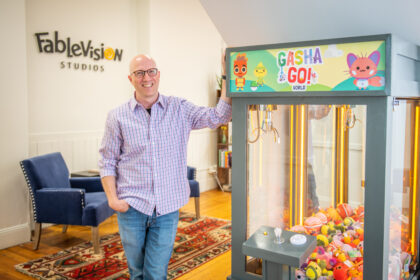‘People will recognize you for your talent’
Many people categorize themselves as left-brained or right-brained. For Gary Goldberger ’96, the magic only happens when the creative and analytical parts of his brain are working in unison.
Goldberger, who majored in physics and fine arts with a focus on sculpture, carved out his career path by merging his understanding of the physical world through science with his ability to connect with others through art. Today, he is the president and co-founder of FableVision Studios, a Boston-based educational media company that creates experiences — everything from books to animations, mobile games to AR and VR — to teach and inspire.

“The realization that both art and science inspire imagination sparked my journey of combining these two worlds,” says Goldberger. “The sciences are amazingly creative but aren’t often put into that box. Artists are super technical, but they’re rarely perceived as technical people. Understanding that these are really the same things, just with different languages, was an ‘aha’ moment for me.”
Goldberger was a transfer student who had studied physics at one university and art at another. At Clark, he was given the freedom and encouragement to combine those passions. He assisted physics professors with programming. When they needed graphs and charts to illustrate concepts for their papers and books, they sought Goldberger’s artistic skills.
These experiences helped Goldberger envision a career path for himself through animation — something he’d been intrigued by since seeing director Tim Burton’s stop-motion wizardry in his film “The Nightmare Before Christmas.” He’s now excited to see Clark students receiving formalized animation instruction in the Becker School of Design & Technology program.
“It’s wonderful that Clark is offering this level of training, and the students are creating incredible projects,” says Goldberger, who has visited campus to check out student work. “They can experiment and learn from making mistakes before starting a full-time job, which is crucial. Coming into the field with a solid base of understanding and hands-on experience opens up a lot of opportunities.”
When FableVision was founded in 1996, Boston was home to more studios.
“Most of the animation studios and interactive studios are gone now, either bought up, acquired, moved out, or closed shop because the industry has changed so much,” says Goldberger. There has been a push for the remaining studios to create games and other vehicles to promote positive social change and education — finding engaging ways to deliver relevant historical, political, and social content. FableVision has added its personal touch to content for PBS, The Jim Henson Company, Nick Jr., Smithsonian, National Geographic Society, and more.
“We’re not a gaming studio and we’re not an animation studio — we’re an engagement studio,” says Goldberger. “Our success came from figuring out what our special talent was and providing a service and a product that was useful for many people.”
Currently, FableVision is collaborating with CyArk and the Hopi Tribe in Arizona to create virtual reality experiences that highlight heritage sites. The team also partnered with the Alaskan Native Tribal consortium Chugachmiut and indigenous educators to create “Nunaka,” an award-winning preschool app that celebrates Sugpiaq heritage and teaches key school readiness skills.
“We always lead with emotion, thought, and education. We want everybody to share their story — that’s the key for us,” says Goldberger. “We create a range of content, but ultimately, we want people to use their voices to become creators. That’s our whole philosophy.”
Over the last few years, Goldberger and the team have collaborated with the Library of Congress on “Civics! An American Musical.” The online game, available on the FableVision Games platform, teaches students how to use primary source documents to create their own musicals by undertaking a process similar to the one director and actor Lin-Manuel Miranda used to create the Broadway musical “Hamilton.”
“It inspires kids to find their voice, share their experiences, and make their own story,” says Goldberger.
 FableVision worked with Georgia Public Broadcasting on a learning platform called GASHA GO! World that teaches computer science and math with adorable characters called “gashlings.” Children are rewarded with a chance to play with a virtual claw machine after they use critical-thinking skills to solve a challenge. This spurred Goldberger to take on another project at the intersection of art and science: he built a life-size, fully functional version of the digital claw machine.
FableVision worked with Georgia Public Broadcasting on a learning platform called GASHA GO! World that teaches computer science and math with adorable characters called “gashlings.” Children are rewarded with a chance to play with a virtual claw machine after they use critical-thinking skills to solve a challenge. This spurred Goldberger to take on another project at the intersection of art and science: he built a life-size, fully functional version of the digital claw machine.
Anyone familiar with GASHA GO! World will immediately recognize the physical claw machine inside the FableVision headquarters on Newbury Street. It’s a focal point of the studio lobby, surrounded by pops of color and custom art.
“It’s a little self-referential, but I’m super excited about it,” says Goldberger. His physics knowledge was useful during construction, but so was the “big kid in me.”
New augmented-reality technology is on the horizon, and Goldberger hopes to discover how it can aid learning pathways for children. He’s currently developing large-scale virtual reality experiences, and advises students to immerse themselves in the latest technology and never stop creating.
“Even if you fail, you learn something,” he says. “Don’t be afraid to share whatever you create. It can be hard to put yourself out there, but people will recognize you for your talent.”


